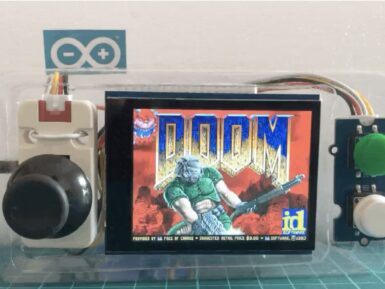
Overview
Based on the ESP8266 Wi-Fi transceiver module and the CH340 USB converter chip, this compact (Open Source) development and prototyping board is ideal for IoT applications.
The Wi-Fi module is compatible with the 802.11 b/g/n standard at 2.4 GHz, has an integrated TCP/IP stack, 19.5 dBm output power, data interface (UART / HSPI / I2C / I2S / Ir Remote Control GPIO / PWM) and PCB antenna.
It also has a micro USB connector and reset button. Programmable with Arduino IDE, it includes interpreters for processing commands for languages such as LUA.
Tech specs
- Model: ESP8266-12E
- Wireless Standard: 802.11 b/g/n
- Frequency range: 2.4 GHz - 2.5 GHz (2400M-2483.5M)
- Wi-Fi mode: Station / SoftAP / SoftAP+station
- Stack: Integrated TCP/IP
- Output power: 19.5dBm in 802.11b mode
- Data interface: UART / HSPI / I2C / I2S / Ir
- Remote Control GPIO / PWM
- Supports protection mode: WPA / WPA2
- Encryption: WEP / TKIP / AES
- Power supply: from 4.5 VDC to 9 VDC (VIN) or via micro USB connector
- Consumption: with continuous Wi-Fi transmission about 70 mA (200 mA MAX) - in standby < 200µA
- Operating temperature: from -40°C to +125°C
- Dimensions (mm): 58×31.20×13
- Weight: 10 grams
Conformities
Get Inspired
Print a claw on your 3D printer and use a myoelectric sensor to control it.

"But can it run Doom?" is more than just a joke in the tech world. It is also a decent litmus test for the computing power of hardware. That test isn't very relevant for modern computers, but it is still worth asking when discussing microcontrollers. Microcontrollers vary in dramatically in processing power and memory, with models to suit every application. But if you have an Arduino Nano ESP32 board, you can run Doom as Naveen Kumar has proven. The Nano ESP32 is a small IoT development board for the ESP32-S3 microcontroller, featuring Wi-Fi® and Bluetooth® connectivity. It also has a relatively high clock speed and quite a lot of memory: 240MHz and 512kB SRAM, respectively. That still isn't enough to meet the requirements of the original Doom release, which needed a lot more RAM. But Kumar demonstrates the use of an MCU-friendly port that runs well on this more limited hardware. Want to give it a try yourself? You'll need the Nano ESP32, an Adafruit 2.8" TFT LCD shield, an M5Stack joystick, a Seeed Studio Grove dual button module, a breadboard, and some jumper wires to create a simple handheld console. You'll have to compile and flash the Retro-Go firmware, which was designed specifically for running games like Doom on ESP32-based devices. You can then load the specialized WAD (Where's All the Data) files. Kumar reports an average frame rate at a 320×240 resolution, which is very playable.






